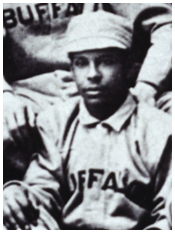

Ulysses F. Grant
Nickname: Frank
Career: 1886-1905
Positions: 2b, ss, p, of, 3b, c
Teams: minor leagues (1886-1888, 1890), Cuban Giants (1889, 1891 1897, 1899), New York Gorhams, Colored Capital All-Americans, New York Big Gorhams (1891), Page Fence Giants (1891), Cuban X-Giants (1899), Philadelphia Giants (1902-1903), Genuine Cuban Giants
Bats: Right
Throws: Right
Height: 5' 7-1/2'' Weight: 155
Born: August 1, 1865, Pittsfield, Massachusetts
Died: May 27, 1937, New York, New York
National Baseball Hall of Fame Inductee (2006)
This second baseman was one of the most outstanding black professional ballplayers of the nineteenth century. Exceptionally quick afield and with a strong arm, he was called the "black Dunlap" in comparison with Fred Dunlap, the best-fielding white second baseman of the 1880s. Most astute baseball observers felt he could have played in the major leagues if he had been provided the opportunity. During his ten-year career, the middle infielder played with the top black clubs of the era, including the Cuban Giants, New York Gorhams, and Philadelphia Giants. He also played with many teams in organized baseball, since the color line had not been officially drawn there. He was a consistent .300 hitter with power, a fast base runner, an outstanding fielder, and a popular player. He was sometimes referred to as a "Spaniard" to make his presence more acceptable, but he still periodically encountered racial prejudice.
The youngest of seven children, he was given the name "Ulysses F." at birth, but his parents began calling him Frank, probably because his father, Franklin, died when he was four months of age. He began playing baseball as a catcher with a Plattsburgh, New York, semi-pro team called "Nameless," but he soon advanced to the professional ranks in 1886 with Meriden, Connecticut, of the Eastern League as a combination second baseman-pitcher, and was the leading hitter with a .316 batting average when the team folded in midsummer and he joined Buffalo, where he hit .344, third best in the International League.
The next season he batted .353 and led the league with 11 home runs and 40 stolen bases in 105 games, and was called the best all-around player in Buffalo's baseball history. But despite his success, his stint in Buffalo was not welcomed by everyone and, most likely attributed to racial pressures, his hitting and fielding were adversely affected. In one game against Toronto, fans were yelling "Kill the n-----!" Despite such tribulations, he remained with Buffalo through the 1888 season and hit .346 (tied for fifth best in the league) and again hit 11 home runs, although injured and missing almost a month of playing time. However, the International League eliminated the use of black players within their league, and Grant signed with the Cuban Giants.
In 1889, to avoid future injuries, he began wearing wooden shinguards for protection from runners coming in with spikes high at second base, and on occasion he was moved to the outfield for his own protection. Grant barnstormed in the South with the Cuban Giants and stayed with the team when they came North to represent Trenton, New Jersey, in the Middle States League, batting .313 for the 1889 season while playing both second base and third base. The next year, he jumped to Harrisburg, Pennsylvania, in the Middle States League. Later in the season the team changed to the Atlantic Association and he hit a composite .333.
In 1891 he played with the Big Gorhams of New York, who represented Ansonia in the Connecticut State League. But the league folded and the team barnstormed as an independent ballclub for the remainder of the year, finishing with a 100-4 record. But despite the team's success on the diamond, financial conditions forced it to fold and he returned to the Cuban Giants for the greater part of the decade. However, in 1898 he played with the Page Fence Giants in their last year before disbanding. After the turn of the century he played with the strong Philadelphia Giants' ballclub in 1902-1903.
After finally leaving the baseball trail, the quiet, modest ex-ballplayer worked as a waiter for a catering service for the last thirty-sit years of his life, and died in New York City in 1937 of arteriosclerosis. He was inducted into the National Baseball Hall of Fame in 2006.
Source: James A. Riley, The Biographical Encyclopedia of the Negro Baseball Leagues, New York: Carroll & Graf Publishers, Inc., 1994.

Frank Grant